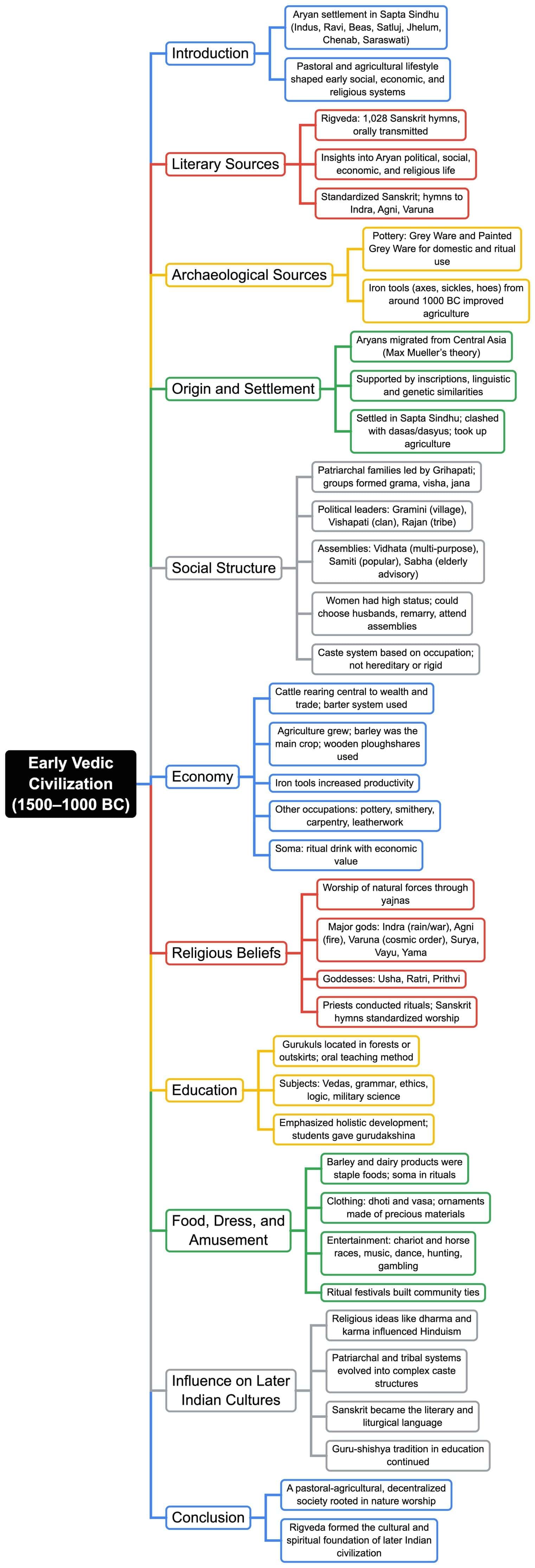Class 9 Exam > Class 9 Notes > History Class 9 ICSE > Mind Map: Early Vedic Civilization
Mind Map: Early Vedic Civilization | History Class 9 ICSE PDF Download

The document Mind Map: Early Vedic Civilization | History Class 9 ICSE is a part of the Class 9 Course History Class 9 ICSE.
All you need of Class 9 at this link: Class 9
|
14 videos|59 docs|16 tests
|
FAQs on Mind Map: Early Vedic Civilization - History Class 9 ICSE
| 1. What were the main features of the Early Vedic Civilization? |  |
Ans. The Early Vedic Civilization, which emerged around 1500 BCE in the Indian subcontinent, was characterized by its pastoral lifestyle, a clan-based social structure, and a deep connection to nature. The society was primarily agrarian, with cattle rearing being a significant aspect of their economy. The Vedic texts, particularly the Rigveda, highlight their religious practices, including rituals and hymns dedicated to various deities. The use of Sanskrit as a language of communication and scripture also marked this civilization, along with the establishment of a four-tier social structure known as the Varna system.
| 2. What role did religion play in the Early Vedic Civilization? |  |
Ans. Religion was central to the Early Vedic Civilization, influencing various aspects of daily life. The people worshipped a pantheon of gods associated with natural elements, such as Agni (fire), Indra (rain and thunder), and Varuna (cosmic order). Rituals and sacrifices were integral to their spiritual practice, often performed by priests known as Brahmins. The Vedic texts served as guidelines for these rituals, reflecting the civilization's beliefs and values, and establishing a foundation for future religious practices in the region.
| 3. How did the social structure of Early Vedic Civilization develop? |  |
Ans. The social structure of Early Vedic Civilization was initially fluid and based on kinship ties, but gradually evolved into a more stratified system known as the Varna system. This structure divided society into four main groups: Brahmins (priests), Kshatriyas (warriors and rulers), Vaishyas (traders and agriculturists), and Shudras (servants and laborers). This categorization became more rigid over time, influencing social interactions, occupations, and the distribution of resources.
| 4. What were the significant contributions of the Early Vedic Civilization to Indian culture? |  |
Ans. The Early Vedic Civilization laid the groundwork for various aspects of Indian culture, including language, philosophy, and religious practices. The development of Sanskrit as a language enriched literature and communication. Additionally, the philosophical ideas found in the Vedic texts contributed to the evolution of Hinduism and various schools of thought. The civilization's emphasis on rituals and the concept of Dharma (duty) continue to influence Indian cultural and ethical norms.
| 5. What are the primary sources of information about the Early Vedic Civilization? |  |
Ans. The primary sources of information about the Early Vedic Civilization are the Vedic texts, particularly the Rigveda, Samaveda, Yajurveda, and Atharvaveda. These texts contain hymns, rituals, and philosophical discourses that provide insights into the beliefs, practices, and social structure of the time. Additionally, archaeological findings, such as tools, pottery, and settlement patterns, help historians reconstruct the lifestyle and environment of the Early Vedic people.
Related Searches




















